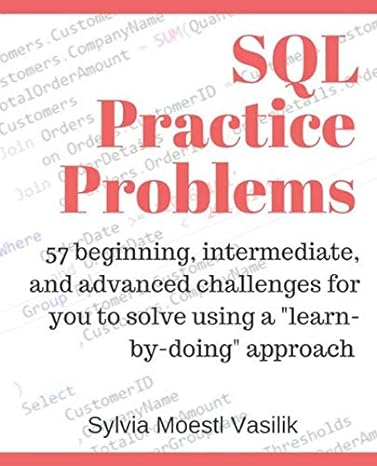Answered step by step
Verified Expert Solution
Question
1 Approved Answer
i only have 30 mins to complete please help Item 1 In the case below, the original source material is given along with a sample
i only have 30 mins to complete please help

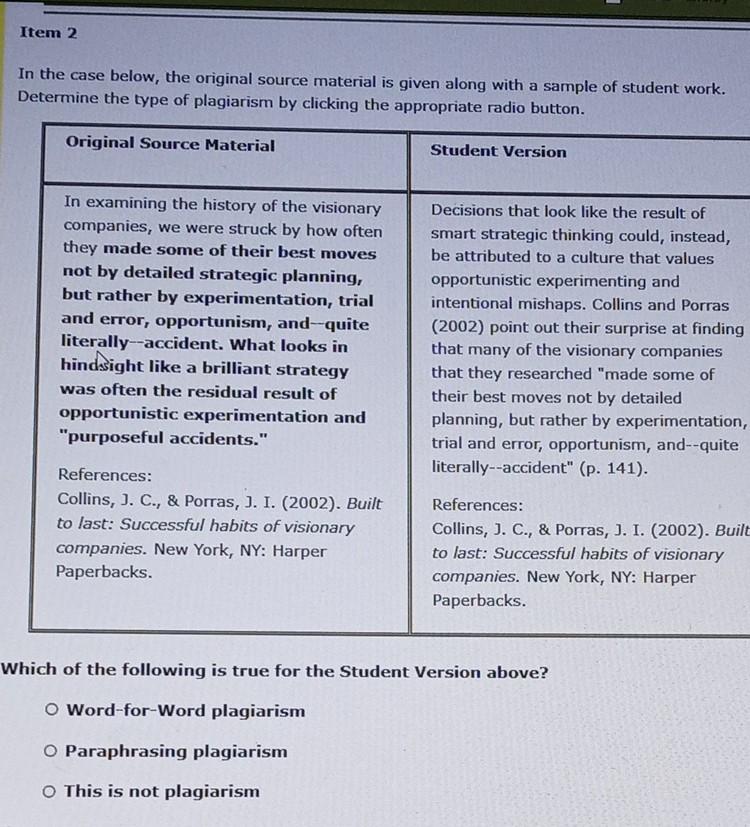
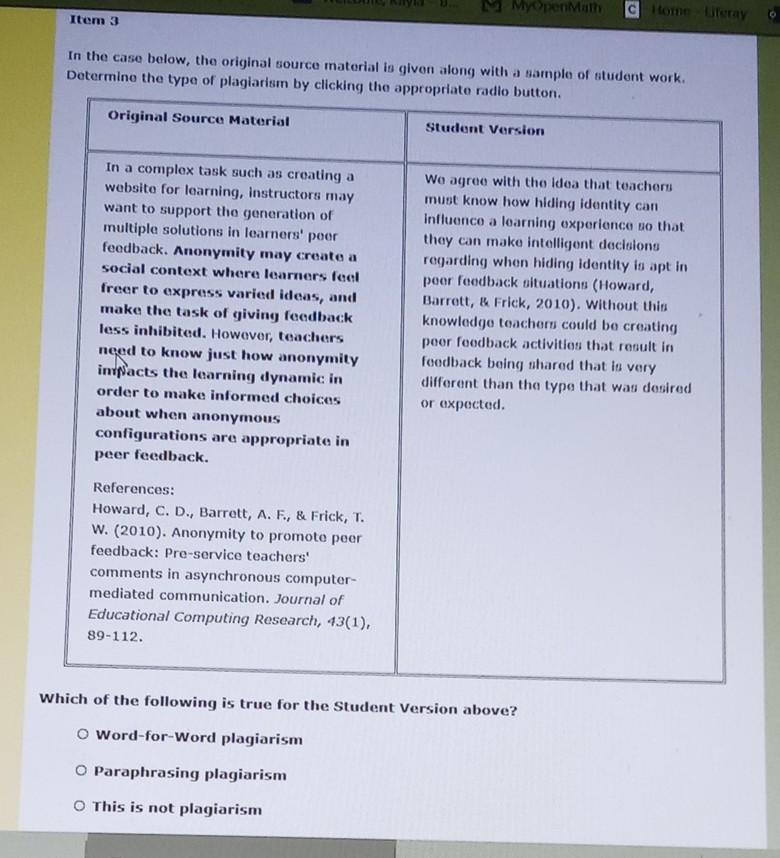

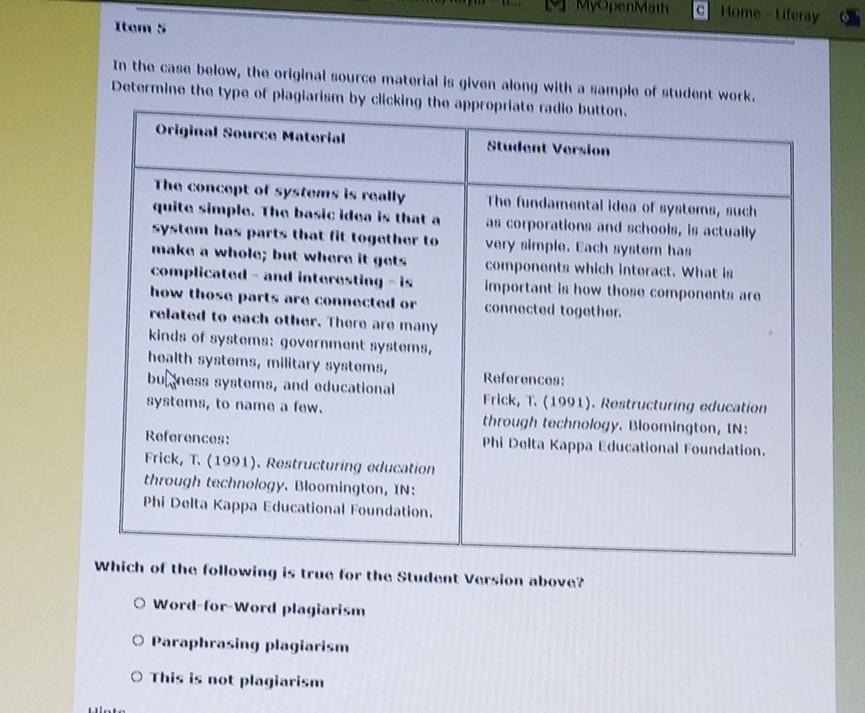
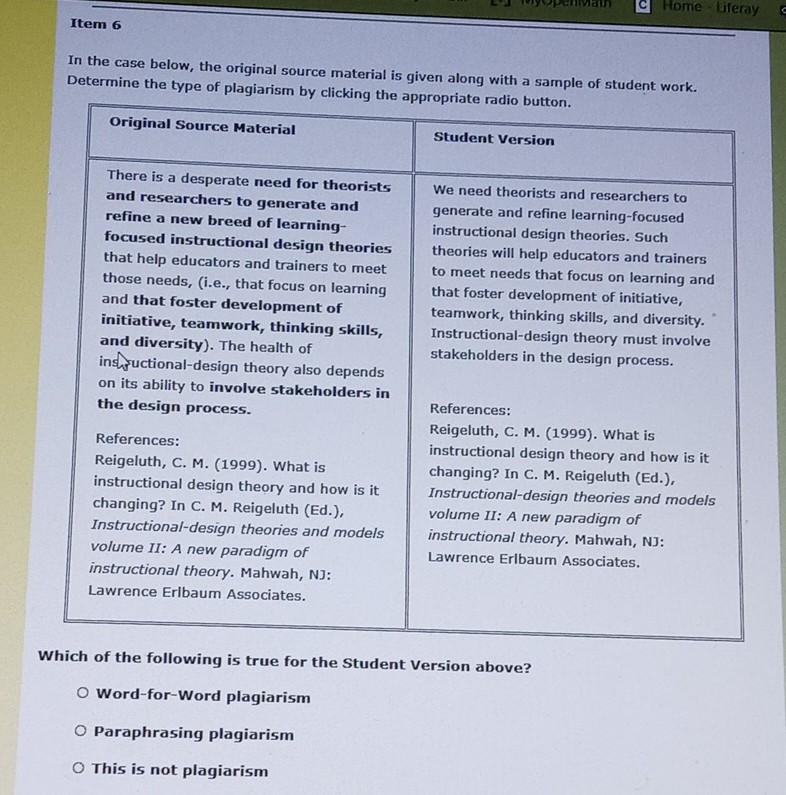
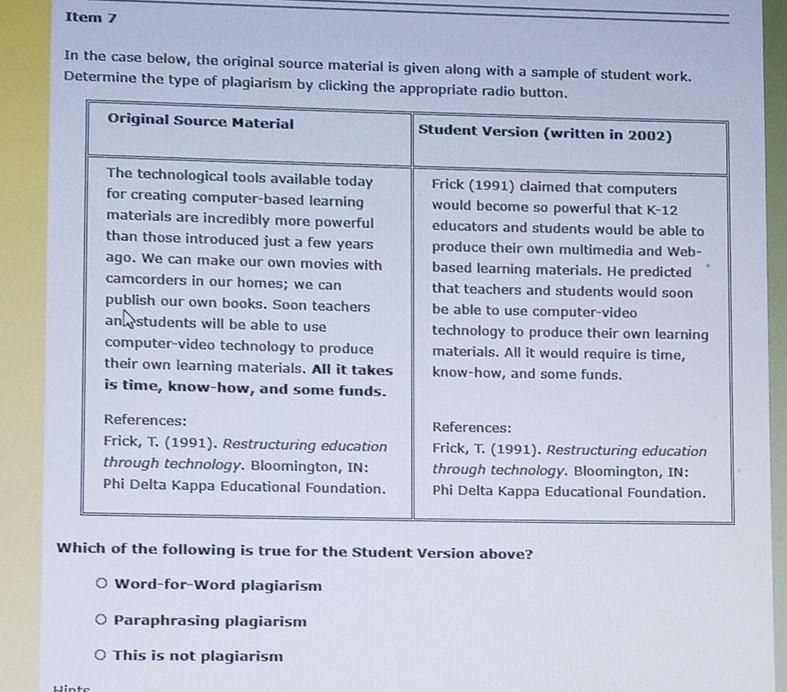

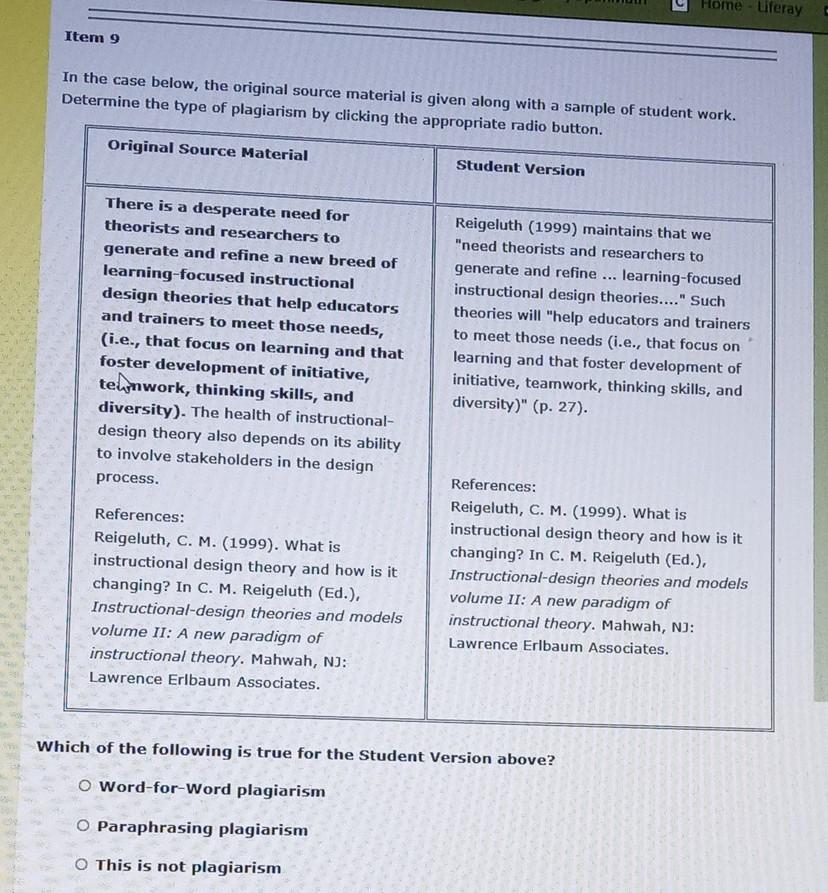
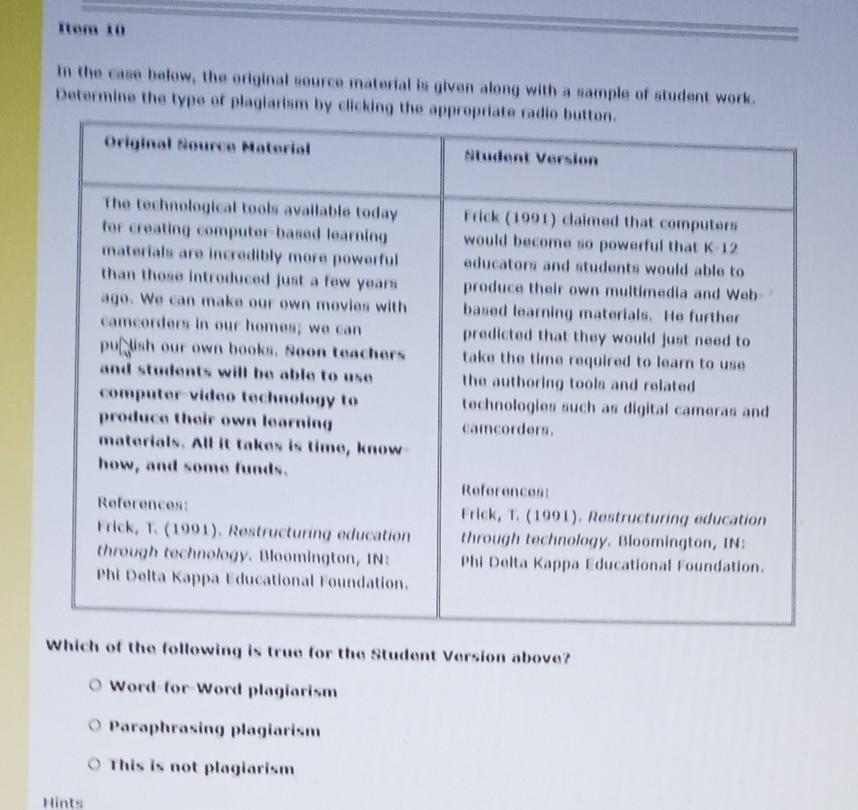
Item 1 In the case below, the original source material is given along with a sample of student work. Determine the type of plagiarism by clicking the appropriate radio button. Original Source Material Student Version (written in 2002) Merck, in fact, epitomizes the ideological nature--the pragmatic idealism--of highly visionary companies. Our research showed that a fundamental element in the "ticking clock" of a visionary company is a core ideology--core values and a sense of purpose beyond just making money--that guides and inspires people throughout the organization and remains relatively fixed for long periods of time. Merck is one of world's biggest pharmaceutical companies. It originated in Germany late in the seventeenth century with operations in the United States starting in the late nineteenth century. As a business, Merck pursues profitable ventures; however, they have established an impressive track record of charitable giving with hundreds of millions in donations. References: Collins, J. C., & Porras, J. I. (2002). Built to last: Successful habits of visionary companies. New York, NY: Harper Paperbacks. Which of the following is true for the Student Version above? O Word-for-Word plagiarism O Paraphrasing plagiarism O This is not plagiarism Item 2 In the case below, the original source material is given along with a sample of student work. Determine the type of plagiarism by clicking the appropriate radio button. Original Source Material Student Version In examining the history of the visionary companies, we were struck by how often they made some of their best moves not by detailed strategic planning, but rather by experimentation, trial and error, opportunism, and--quite literally--accident. What looks in hindsight like a brilliant strategy was often the residual result of opportunistic experimentation and "purposeful accidents." Decisions that look like the result of smart strategic thinking could, instead, be attributed to a culture that values opportunistic experimenting and intentional mishaps. Collins and Porras (2002) point out their surprise at finding that many of the visionary companies that they researched "made some of their best moves not by detailed planning, but rather by experimentation, trial and error, opportunism, and-- quite literally-accident" (p. 141). References: Collins, J. C., & Porras, J. I. (2002). Built to last: Successful habits of visionary companies. New York, NY: Harper Paperbacks. References: Collins, J. C., & Porras, J. I. (2002). Built to last: Successful habits of visionary companies. New York, NY: Harper Paperbacks. Which of the following is true for the Student Version above? O Word-for-Word plagiarism O Paraphrasing plagiarism This is not plagiarism M MyopenMan C Home Diferay Item 3 In the case below, the original source material is given along with a sample of student work. Determine the type of plagiarism by clicking the appropriate radio button. Original Source Material student Version In a complex task such as creating a website for learning, instructors may want to support the generation of multiple solutions in learners' poer feedback. Anonymity may create a social context where learners feel freer to express varied ideas, and make the task of giving feedback less inhibited. However, teachers need to know just how anonymity intpacts the learning dynamic in order to make informed choices about when anonymous configurations are appropriate in peer feedback. We agree with the idea that teachers must know how hiding identity can influence a learning experience so that they can make intelligent decisions regarding when hiding identity is apt in poor feedback situations (Howard, Barrett, & Frick, 2010). Without this knowledge teachers could be creating poor foodback activities that result in foodback being shared that is very different than the type that was desired or expected. References: Howard, C. D., Barrett, A. F., & Frick, T. W. (2010). Anonymity to promote peer feedback: Pre-service teachers' comments in asynchronous computer- mediated communication. Journal of Educational Computing Research, 43(1), 89-112. Which of the following is true for the Student Version above? O Word-for-Word plagiarism O Paraphrasing plagiarism This is not plagiarism Item 4 In the case below, the original source material is given along with a sample of student work. Determine the type of plagiarism by clicking the appropriate radio button. Original Source Material Student Version In examining the history of the visionary companies, we were struck by how often they made some of their best moves not by detailed strategic planning, but rather by experimentation, trial and error, opportunism, and--quite literally- accident. What looks in hindsight like a brilliant strategy was often the rewdual result of opportunistic experimentation and "purposeful accidents." The variety of projects that Google undertakes, from Internet search to cars that drive themselves, could be considered lack of focus. However, perhaps Google recognizes that successful moves that looked like the result of "a brilliant strategy was often the residual result of opportunistic experimentation" (Collins & Porras, 2002, p. 141). References: Collins, J. C., & Porras, J. I. (2002). Built to last: Successful habits of visionary companies. New York, NY: Harper Paperbacks. References: Collins, J. C., & Porras, J. I. (2002). Built to last: Successful habits of visionary companies. New York, NY: Harper Paperbacks. Which of the following is true for the Student Version above? o Word-for-Word plagiarism Paraphrasing plagiarism This is not plagiarism Hints Myopen Math Home Liferay In the case below, the original source material is given along with a sample of student work. Determine the type of plagiarism by clicking the appropriate radio button. Original source Material Student Version The concept of systems is really quite simple. The basic idea is that a system has parts that fit together to make a whole; but where it gets complicated and interesting is how those parts are connected or related to each other. There are many kinds of systems: government systems, health systems, military systems, buness systems, and educational systems, to name a few. The fundamental idea of syntemn, such as corporations and schools, is actually very simple. Each syntem han components which interact. What la Important in how those components are connected together References: Frick, T. (1901). Restructuring education through technology. Bloomington, IN: Phi Delta Kappa Educational Foundation, References: Frick, T. (1991). Restructuring education through technology. Bloomington, IN: Phi Delta Kappa Educational Foundation. Which of the following is true for the Student Version above? Word for Word plagiarism O Paraphrasing plagiarism This is not plagiarism Lilnto C Home feray Item 6 In the case below, the original source material is given along with a sample of student work. Determine the type of plagiarism by clicking the appropriate radio button. Original Source Material Student Version There is a desperate need for theorists and researchers to generate and refine a new breed of learning- focused instructional design theories that help educators and trainers to meet those needs, (i.e., that focus on learning and that foster development of initiative, teamwork, thinking skills, and diversity). The health of inshsuctional-design theory also depends on its ability to involve stakeholders in the design process. We need theorists and researchers to generate and refine learning-focused instructional design theories. Such theories will help educators and trainers to meet needs that focus on learning and that foster development of initiative, teamwork, thinking skills, and diversity. Instructional-design theory must involve stakeholders in the design process. References: Reigeluth, C. M. (1999). What is instructional design theory and how is it changing? In C. M. Reigeluth (Ed.), Instructional-design theories and models volume II: A new paradigm of instructional theory. Mahwah, NJ: Lawrence Erlbaum Associates. References: Reigeluth, C. M. (1999). What is instructional design theory and how is it changing? In C. M. Reigeluth (Ed.), Instructional-design theories and models volume II: A new paradigm of instructional theory. Mahwah, NJ: Lawrence Erlbaum Associates. Which of the following is true for the Student Version above? O Word-for-Word plagiarism O Paraphrasing plagiarism This is not plagiarism Item 7 In the case below, the original source material is given along with a sample of student work. Determine the type of plagiarism by clicking the appropriate radio button. Original Source Material Student Version (written in 2002) The technological tools available today for creating computer-based learning materials are incredibly more powerful than those introduced just a few years ago. We can make our own movies with camcorders in our homes; we can publish our own books. Soon teachers anh-students will be able to use computer-video technology to produce their own learning materials. All it takes is time, know-how, and some funds. Frick (1991) claimed that computers would become so powerful that K-12 educators and students would be able to produce their own multimedia and Web- based learning materials. He predicted that teachers and students would soon be able to use computer-video technology to produce their own learning materials. All it would require is time, know-how, and some funds. References: Frick, T. (1991). Restructuring education through technology. Bloomington, IN: Phi Delta Kappa Educational Foundation. References: Frick, T. (1991). Restructuring education through technology. Bloomington, IN: Phi Delta Kappa Educational Foundation. Which of the following is true for the Student Version above? O Word-for-Word plagiarism O Paraphrasing plagiarism This is not plagiarism Linte Item 8 In the case below, the original source material is given along with a sample of student work. Determine the type of plagiarism by clicking the appropriate radio button. Original Source Material Student Version In contrast to the transmittal model illustrated by the classroom lecture-note taking scenario, the constructivist model places students at the center of the process--actively participating in thinking and discussing ideas while making meaning for themselves. And the professor, instead of being the "sage orthe stage," functions as a "guide on the side," facilitating learning in less directive ways. Considering the major changes and shifts in educational needs of today's society. the need for a new paradigm of education has emerged. This new paradigm of education requires a major change in the role of teachers from being the sage on the stage to a guide on the side, facilitating learning in less directive ways. References: King, A. (1993). From sage on the stage to guide on the side. College Teaching, 41, 30-35. References: King, A. (1993). From sage on the stage to guide on the side. College Teaching, 41, 30-35. Which of the following is true for the Student Version above? O Word-for-Word plagiarism O Paraphrasing plagiarism O This is not plagiarism Hints Home Uferay Item 9 In the case below, the original source material is given along with a sample of student work. Determine the type of plagiarism by clicking the appropriate radio button. Original Source Material Student Version . There is a desperate need for theorists and researchers to generate and refine a new breed of learning-focused instructional design theories that help educators and trainers to meet those needs, (i.e., that focus on learning and that foster development of initiative, teunwork, thinking skills, and diversity). The health of instructional- design theory also depends on its ability to involve stakeholders in the design process. Reigeluth (1999) maintains that we "need theorists and researchers to generate and refine learning-focused instructional design theories...." Such theories will "help educators and trainers to meet those needs (i.e., that focus on learning and that foster development of initiative, teamwork, thinking skills, and diversity)" (p. 27). References: Reigeluth, C. M. (1999). What is instructional design theory and how is it changing? In C. M. Reigeluth (Ed.), Instructional-design theories and models volume II: A new paradigm of instructional theory. Mahwah, NJ: Lawrence Erlbaum Associates. References: Reigeluth, C. M. (1999). What is instructional design theory and how is it changing? In C. M. Reigeluth (Ed.), Instructional-design theories and models volume II: A new paradigm of instructional theory. Mahwah, NJ: Lawrence Erlbaum Associates. Which of the following is true for the Student Version above? o Word-for-Word plagiarism O Paraphrasing plagiarism O This is not plagiarism Item 10 in the case below, the original source material is given along with a sample of student work Determine the type of plagiarism by clicking the appropriate radio button Original Nource Material Student Version The technological tools available today for creating computer based learning materials are incredibly more powerful than those introduced just a few year ago. We can make our own movies with camcorders in our homen; we can push our own books. Noon teachers and students will be able to use computer video technology to produce their own learning materials. All it takes is time, know how, and some funds Frick (1091) daimed that computers would become so powerful that K 12 aducatori and students would able to produce their own multimedia and Web baued learning materials. He further predicted that they would just need to take the time required to learn to use the authoring tools and related technologies such an digital cameras and camcorder References Frick, 1. (1901). Restructuring education through technology. Bloomington, IN Phi Delta Kappa Educational Foundation, References Frick, T. (1001). Restructuring education through technology, Bloomington, IN: Phi Delta Kappa Educational Foundation, which of the following is true for the Student Version above? O Word for Word plagiarism Paraphrasing plagiarism This is not plagiarism Hints
Step by Step Solution
There are 3 Steps involved in it
Step: 1

Get Instant Access to Expert-Tailored Solutions
See step-by-step solutions with expert insights and AI powered tools for academic success
Step: 2

Step: 3

Ace Your Homework with AI
Get the answers you need in no time with our AI-driven, step-by-step assistance
Get Started


